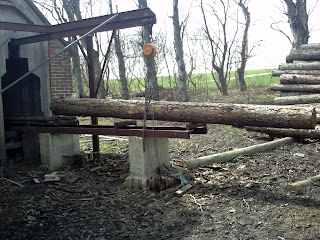The idea is to keep the glass in place by means of a small angle shaped strip of wood that can be tacked into place by means of some small tacks or screws.
I doubt that I will ever need to change the glass, but it will give me great satisfaction to know that the possibility is there even for my successors if the glass should ever break.
The frame for the glass is built up using a home made profile that looks kind of like a W.
At first I tried to make a concealed mitered dovetail - that didn't work out. Then I tried to make it like a concealed tenon joint. That didn't work either. So finally I sawed the pieces in 45 degrees, and glued it up using the most unreliable end grain to end grain constellation.
The things were held in place by masking tape which is not blue on this side of the Atlantic, but more like a light yellow or cream colour. Anyway it works the same way.
After several hours of drying time (6 hours) I glued up the posts of the frame. These hold the upper and lower part together and they add some normal long grain to the intersection. So my hope is, that it will help to keep it all together. After all, it is not the most stressed piece of furniture so I expect it to hold just fine.
Yesterday was my 40th birthday, and I got some really nice presents. I had ordered some of them myself, to help my wife, but it was still a pleasant thing to open them. A Veritas skewed rabbet plane, some wood wax from Dictum due to the excellent review from Brian: http://toolerable.blogspot.dk/2013/02/using-polissoir-and-meeting-snakeye.html
and a book: Das Zimmermannsbuch, a reprint of a carpenters book from 1895 (in German).
My father had bought a nice old Japanese plane and a 1200 grit water stone.
After the guests had left, I decided to try out the Japanese plane which was sharpened and ready to go. After a little fiddling, I produced some nice shavings. I wondered if it was possible to make them thinner, so I fiddled some more.. And suddenly I made the most fantastic ultra thin shavings. And the smell from the larch was incredible. So actually a really nice way of ending a birthday.
One of the frames showing the W shaped profile.
The post being inserted from the left to give an idea of the assembly method.
The complete glued up frame
The blade of the new (old) plane
The first shavings
Better looking shavings



















































